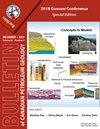The Steepbank Formation: a paleokarst diamictite deposit in the Athabasca Oil Sands region of northeastern Alberta, Canada
Q3 Earth and Planetary Sciences
引用次数: 3
Abstract
Abstract The name “Steepbank Formation” is proposed for a paleokarst diamictite deposit that is present along the margins of the Middle Devonian Prairie Evaporite Formation in the Western Canada and Williston sedimentary basins, including the eastern portion of the Athabasca Oil Sands region. This poorly lithified diamictite forms a mappable unit that is distinct in both age and lithology from all contiguous formations. The Steepbank consists of clasts of dolostone, limestone, and siltstone up to the size of boulders with a matrix of silty to sandy calcareous mudstone. The material shows little or no evidence of bedding or sorting. Most clasts are angular and their orientation is commonly random. The diamictite formed in response to the dissolution of thick (up to 300 m) sequences of halite, anhydrite, and gypsum in the Prairie Evaporite Formation and the subsequent failure and collapse of interbedded and overlying insoluble strata. The top contact occurs where the intact strata of an overlying formation can be identified and is commonly gradational. The basal contact with the underlying Keg River Formation is sharp. Both contacts are unconformable. Evaporite dissolution and diamicton deposition likely began in late Middle Devonian time, moving down dip toward the west, and are continuing today near the Athabasca River.陡岸组:加拿大艾伯塔省东北部阿萨巴斯卡油砂区的一个古岩溶杂岩矿床
摘要“陡岸组”是指加拿大西部和Williston沉积盆地(包括阿萨巴斯卡油砂区东部)中泥盆纪草原蒸发岩组边缘的一个古岩溶杂岩矿床。这种岩化不良的杂岩形成了一个可绘制的单元,在年龄和岩性上与所有相邻的地层都不同。陡岸由白云岩、石灰岩和粉砂岩的碎屑组成,其大小可达巨石,基质为粉砂质至砂质钙质泥岩。这些材料很少或根本没有显示出层理或分选的迹象。大多数碎屑都是有角度的,它们的方向通常是随机的。杂岩是由于草原蒸发岩组中厚(高达300m)的石盐、硬石膏和石膏序列的溶解以及随后互层和上覆不溶性地层的破坏和坍塌而形成的。顶部接触发生在可以识别上覆地层完整地层的地方,通常是渐变的。与下伏Keg河组的基底接触是尖锐的。两个接触面都不整合。蒸发岩溶解和二明石沉积可能始于中泥盆纪晚期,向西倾斜,并在阿萨巴斯卡河附近持续至今。
本文章由计算机程序翻译,如有差异,请以英文原文为准。
求助全文
约1分钟内获得全文
求助全文
来源期刊

Bullentin of Canadian Petroleum Geology
Earth and Planetary Sciences-Geochemistry and Petrology
CiteScore
2.50
自引率
0.00%
发文量
0
期刊介绍:
The Bulletin of Canadian Petroleum Geology is a peer-reviewed scientific journal published four times a year. Founded in 1953, the BCPG aims to be the journal of record for papers dealing with all aspects of petroleum geology, broadly conceived, with a particularly (though not exclusively) Canadian focus. International submissions are encouraged, especially where a connection can be made to Canadian examples.
 求助内容:
求助内容: 应助结果提醒方式:
应助结果提醒方式:


